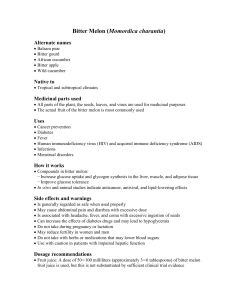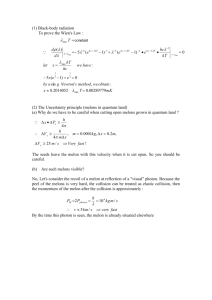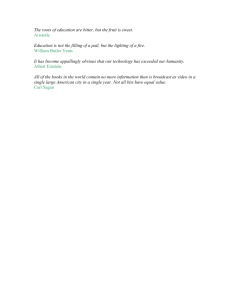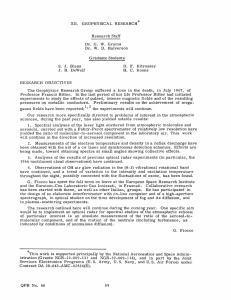Document 13308278
advertisement
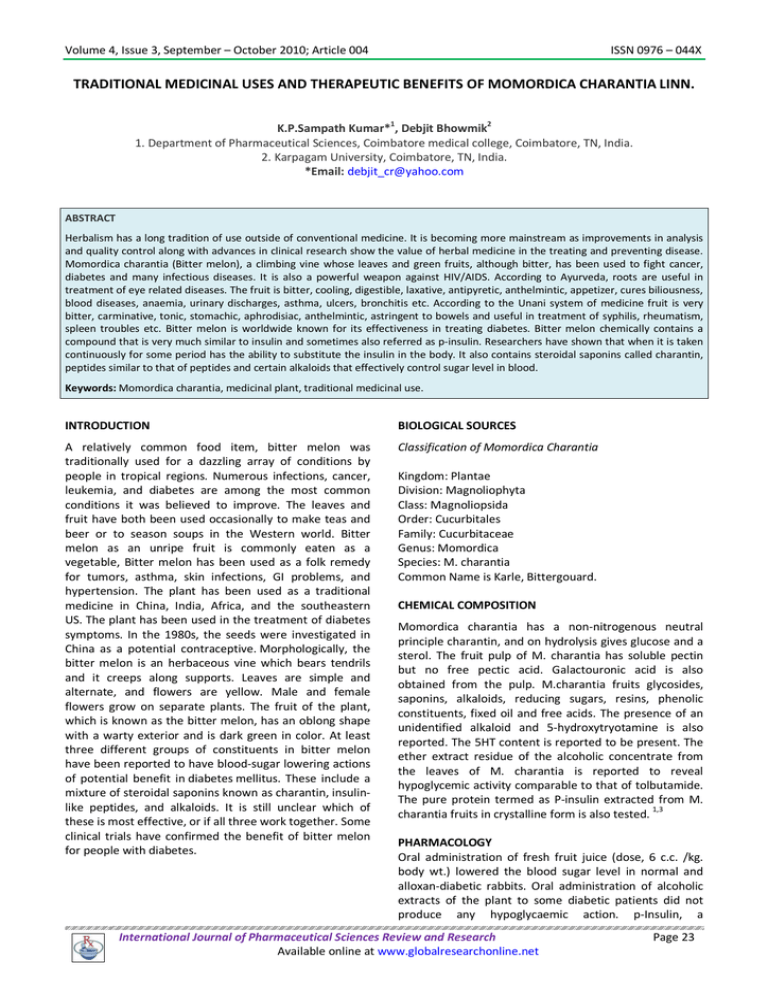
Volume 4, Issue 3, September – October 2010; Article 004 ISSN 0976 – 044X TRADITIONAL MEDICINAL USES AND THERAPEUTIC BENEFITS OF MOMORDICA CHARANTIA LINN. 1 2 K.P.Sampath Kumar* , Debjit Bhowmik 1. Department of Pharmaceutical Sciences, Coimbatore medical college, Coimbatore, TN, India. 2. Karpagam University, Coimbatore, TN, India. *Email: debjit_cr@yahoo.com ABSTRACT Herbalism has a long tradition of use outside of conventional medicine. It is becoming more mainstream as improvements in analysis and quality control along with advances in clinical research show the value of herbal medicine in the treating and preventing disease. Momordica charantia (Bitter melon), a climbing vine whose leaves and green fruits, although bitter, has been used to fight cancer, diabetes and many infectious diseases. It is also a powerful weapon against HIV/AIDS. According to Ayurveda, roots are useful in treatment of eye related diseases. The fruit is bitter, cooling, digestible, laxative, antipyretic, anthelmintic, appetizer, cures biliousness, blood diseases, anaemia, urinary discharges, asthma, ulcers, bronchitis etc. According to the Unani system of medicine fruit is very bitter, carminative, tonic, stomachic, aphrodisiac, anthelmintic, astringent to bowels and useful in treatment of syphilis, rheumatism, spleen troubles etc. Bitter melon is worldwide known for its effectiveness in treating diabetes. Bitter melon chemically contains a compound that is very much similar to insulin and sometimes also referred as p-insulin. Researchers have shown that when it is taken continuously for some period has the ability to substitute the insulin in the body. It also contains steroidal saponins called charantin, peptides similar to that of peptides and certain alkaloids that effectively control sugar level in blood. Keywords: Momordica charantia, medicinal plant, traditional medicinal use. INTRODUCTION BIOLOGICAL SOURCES A relatively common food item, bitter melon was traditionally used for a dazzling array of conditions by people in tropical regions. Numerous infections, cancer, leukemia, and diabetes are among the most common conditions it was believed to improve. The leaves and fruit have both been used occasionally to make teas and beer or to season soups in the Western world. Bitter melon as an unripe fruit is commonly eaten as a vegetable, Bitter melon has been used as a folk remedy for tumors, asthma, skin infections, GI problems, and hypertension. The plant has been used as a traditional medicine in China, India, Africa, and the southeastern US. The plant has been used in the treatment of diabetes symptoms. In the 1980s, the seeds were investigated in China as a potential contraceptive. Morphologically, the bitter melon is an herbaceous vine which bears tendrils and it creeps along supports. Leaves are simple and alternate, and flowers are yellow. Male and female flowers grow on separate plants. The fruit of the plant, which is known as the bitter melon, has an oblong shape with a warty exterior and is dark green in color. At least three different groups of constituents in bitter melon have been reported to have blood-sugar lowering actions of potential benefit in diabetes mellitus. These include a mixture of steroidal saponins known as charantin, insulinlike peptides, and alkaloids. It is still unclear which of these is most effective, or if all three work together. Some clinical trials have confirmed the benefit of bitter melon for people with diabetes. Classification of Momordica Charantia Kingdom: Plantae Division: Magnoliophyta Class: Magnoliopsida Order: Cucurbitales Family: Cucurbitaceae Genus: Momordica Species: M. charantia Common Name is Karle, Bittergouard. CHEMICAL COMPOSITION Momordica charantia has a non-nitrogenous neutral principle charantin, and on hydrolysis gives glucose and a sterol. The fruit pulp of M. charantia has soluble pectin but no free pectic acid. Galactouronic acid is also obtained from the pulp. M.charantia fruits glycosides, saponins, alkaloids, reducing sugars, resins, phenolic constituents, fixed oil and free acids. The presence of an unidentified alkaloid and 5-hydroxytryotamine is also reported. The 5HT content is reported to be present. The ether extract residue of the alcoholic concentrate from the leaves of M. charantia is reported to reveal hypoglycemic activity comparable to that of tolbutamide. The pure protein termed as P-insulin extracted from M. 1,3 charantia fruits in crystalline form is also tested. PHARMACOLOGY Oral administration of fresh fruit juice (dose, 6 c.c. /kg. body wt.) lowered the blood sugar level in normal and alloxan-diabetic rabbits. Oral administration of alcoholic extracts of the plant to some diabetic patients did not produce any hypoglycaemic action. p-Insulin, a International Journal of Pharmaceutical Sciences Review and Research Available online at www.globalresearchonline.net Page 23 Volume 4, Issue 3, September – October 2010; Article 004 ISSN 0976 – 044X polypeptide from the fruits and seeds rapidly decreased and normalized the blood sugar level in rats. 1,2,6 properties. It is also anti-flatulent. (v) Bitter melon is used in the dissolution of fats from the body. It is known to have anti-lipolytic properties. (vi) Bitter melon possesses all the essential vitamins in good amounts, such as vitamin A, thiamine, riboflavin, vitamin C and also minerals like iron. (vii) Bitter melon is anti-inflammatory and astringent. It has specific action on the movement of bowels. 5,6 PROPERTIES Bitter melon is a valuable vegetable. It is useful in most metabolic and physiological processes of the human body. It has the following properties:(i) Bitter melon is composed of various chemicals that have a hypoglycemic activity, i.e. they reduce the amount of sugar in the blood. (ii) Bitter melon stimulates appetite. (iii) Bitter melon helps in the entire digestion process. Hence it is used in treatment of digestive problems. (iv) Bitter melon has emetic, purgative and anthelmentic GENERAL DESCRIPTION: It is under cultivation for its fruits which are used as vegetable. All parts of Karela especially the fruits are used as folk medicine also. Its use in treatment of Diabetes has established it as popular medicinal herb. (Table 1) Table 1: Botanical differences among the major Momordica species of India. M. charantia M. dioica M. balsamina Plant A much branched climbing annual a dioecious, perennial climber with a tuberous root A monoecious, much branched, climbing perennial from a tuberous root Stem Angled, grooved, young parts densely hairy, older branches more or less pubescent slender, glabrous to rarely slender, glabrous sparsely pubescent, angled and sulcate Leaves almost orbicular or reniform in outiline, lobes ovate-oblong, acute or subacute, apiculate Much variable, membranous, ovate, obtuse or acute and mucronate, lobes triangular Herbaceous or slightly hairy particularly on nerves beneath, lobes rhomboid or obovate to elliptic-rhomboid Flowers monoecious, male flowers solitary, peduncles slender, glabrous or slightly pubescent; Corolla some what irregular, lemon yellow; Female flowers on 5-10 cm long slender peduncles, bracteate usually at or near the base Male flowers solitary, glabours peduncles which are hairy, Corolla yellow, Female flowers bracteate or ebracteate Monoecious, all solitary; Male flowers on slender, filiform peduncles, glabrous or somewhat hairy towards apex, corolla pale yellow; Female flowers on ebracteate or bracteate penducles Fruit Bright orange coloured, 5-15 cm long, fusiform, ribbed, with numerous triangular tubercles giving it the appearance of crocodile skin Ellipsoid, shortly beaked, densely echinate with soft spines, apex shortly rostrate and annular, base usually rounded Subglobose to ovoid, with a broad, conical rostrum, abruptly and shortly attenuate at base, bright orange-red to scarlet when ripe Seeds compressed, oblong, sub-bidentate at base and many, much variable in size with a carmine red arillus, grey, ovate or apex, sculptured on sides, cream or greyand shape, turgid, more or less oblong in outline, compressed coloured puriforms quite smooth BITTER MELON HERBAL PROPERTIES AND ACTIONS Main Actions Other Actions Standard Dosage kills bacteria reduces inflammation Leaves, Fruit kills viruses fights free radicals Decoction: 1 cup 1-2 times daily kills cancer cells enhances libido Tincture: 1-3 ml twice daily kills leukemia cells cleanses blood Capsules: 1 g twice daily prevents tumors detoxifies treats diabetes expels worms reduces blood sugar balances hormones reduces blood pressure enhances immunity lowers body temperature mildly laxative lowers cholesterol promotes milk flow International Journal of Pharmaceutical Sciences Review and Research Available online at www.globalresearchonline.net Page 24 Volume 4, Issue 3, September – October 2010; Article 004 ISSN 0976 – 044X WORLDWIDE ETHNOMEDICAL USES Brazil for abortions, burns, colic, constipation, dermatosis, diabetes, diarrhea, eczema, fever, flu, hemorrhoids, hepatitis, hives, itch, impotency, leprosy, leukemia, libido, liver inflammation, malaria, menstrual problems, pain, rheumatism, scabies, skin, tumor, vaginal discharge, vaginitis, worms, wounds China for breast cancer, diabetes, fever, halitosis, impotency, renal insufficiency, kidney problems Cuba for anemia, colitis, diabetes, fever, hyperglycemia, intestinal parasites, kidney stones, liver problems, menstrual problems, sterility (female), worms Haiti for anemia, constipation, dermatosis, eye infections, fever, liver diseases, skin problems, rhinitis, and as an appetite stimulant and insecticide India for abortions, birth control, constipation, diabetes, eczema, fat loss, food, fever, gout, hemorrhoids, hydrophobia, hyperglycemia, increasing milk flow, intestinal parasites, jaundice, kidney stones, leprosy, liver, menstrual disorders, pneumonia, psoriasis, rheumatism, scabies, skin, snakebite, vaginal discharge Mexico for bowel function, burns, diabetes, dysentery, impotency, libido, scabies, sores, worms Malaya for abdominal pain, asthma, burns, Celiac's disease, dermatosis, diarrhea, headache, intestinal parasites, stomachache, worms Nicaragua for aches, anemia, childbirth, colds, constipation, cough, diabetes, fever, headache, hypertension, infections, lung disorders, malaria, pain, pregnancy, rashes, skin problems Panama for colds, diabetes, fever, flu, gallbladder problems, hives, hypertension, itch, malaria, menstrual problems, and as an insecticide Peru for colic, constipation, contusions, diabetes, diarrhea, fever, hepatitis, inflammation, intestinal parasites, lung problems, malaria, measles, menstrual problems, skin sores, pus, wounds Trinidad for diabetes, dysentery, fever, hypertension, malaria, rheumatism, worms MEDICINAL USES OF MOMORDICA CHARANTIA Bitter gourd is rich in nutrients like thiamine, betacarotene, foliate, riboflavin and minerals like calcium, iron, phosphorus, manganese, potassium, magnesium, zinc and dietary fiber. Regular use of bitter gourd juice boosts body stamina and prevents chronic fatigue. The beta-carotene content in bitter gourd helps in controlling eye disorders and enhances eyesight. 4,5 1) Bitter melon stimulates a sluggish digestive system and treats dyspepsia. However, since it promotes secretion of acid, it may make an existing ulcerous condition worse. 2) Scientific studies show that fresh juice of bitter melon can lower blood sugar values and keep insulin under check. The hypoglycemic (blood sugar lowering) action is due to the presence of a unique phyto-constituent called charantin, insulin-like peptides, and alkaloids, all of which act together to improve glucose tolerance without increasing blood insulin levels. These compounds activate a protein called AMPK, which regulates fuel metabolism and enables glucose uptake, processes which are impaired in diabetics. Bitter melon has been found to increase the number of insulin-secreting beta cells in the pancreas. Multiple clinical studies have documented the efficacy of bitter gourd, and several pharmaceutical companies have jumped in and included them in their formulations. 3) Bitter gourd juice can also prevent jaundice by strengthening the liver. By detoxifying and nourishing liver, bitter melon juice may be beneficial in the treatment of a hangover. 4) Researchers hypothesize that bitter melon is as an immunomodulator. One clinical trial found limited evidence that bitter melon might improve immune cell function in people with cancer. If proved, bitter melon could help people infected with HIV. Other potential uses include treatment for fever, the cold and flu, malaria, cancer and tumors, high cholesterol, and psoriasis. 5) Piles: A popular folk remedy is to mix three teaspoonfuls of juice from bitter melon leaves with a glassful of buttermilk to be taken every morning for about a month on empty stomach. 6) Cholera: Fresh juice of leaves of bitter gourd is also an effective medicine in early stages of cholera and 5,6,9 other types of diarrhea. Caution Excessively high doses of bitter melon juice can cause abdominal pain and diarrhea. Anyone with hypoglycemia should not take bitter melon because this may worsen low blood sugar. Pregnant women should avoid taking International Journal of Pharmaceutical Sciences Review and Research Available online at www.globalresearchonline.net Page 25 Volume 4, Issue 3, September – October 2010; Article 004 ISSN 0976 – 044X too much bitter gourd or its juice as it may stimulate the uterus that may lead to preterm labor. In traditional herbal medicine, bitter melon—like other bitter-tasting herbs—is thought to stimulate digestive function and improve appetite. leprosy and large wounds. It is also used to cure hypertension, malaria, fevers and headaches. It also has good results in expelling worms and parasites in adults and children if taken internally. It is also effective against numerous viruses, herpes and HIV viruses. BENEFITS OF BITTER MELON The bitter melon or bitter gourd is the bitterest of all vegetables known to humankind, but it is also the most medicinally effective. Though bitter, its fruit is eaten as a vegetable and is used to make several mouthwatering dishes especially in India. In India, the bitter gourd is known as the karela. Its biological name is Momordica charantia. 1. 2. 3. Bitter melon is worldwide known for its effectiveness in treating diabetes. Bitter melon chemically contains a compound that is very much similar to insulin and sometimes also referred as p-insulin. Researchers have shown that when it is taken continuously for some period has the ability to substitute the insulin in the body. It also contains steroidal saponins called charantin, peptides similar to that of peptides and certain alkaloids that effectively control sugar level in 5 blood. Bitter melon is also good digestive agent and helps in stimulating the secretion of gastric juices. It is very helpful in stimulating liver for secretion of bile juices that are very essential for metabolism of fats. It helps in improving the peristaltic movements hence it is very helpful in avoiding gastric disturbances. Taking bitter melon juice also helps in the treatment of constipation. Constipation is mainly caused due to faulty eating habits and unhealthy dietary practices. Bitter melon not only relives from the indigestive condition but also helps in combating the constipation. It improves peristaltic movements of gastro intestinal tract and also improves the absorption in the intestines. 7,8 Morphologically, the bitter melon is an herbaceous vine which bears tendrils and it creeps along supports. Leaves are simple and alternate, and flowers are yellow. Male and female flowers grow on separate plants. The fruit of the plant, which is known as the bitter melon, has an oblong shape with a warty exterior and is dark green in color. Bitter melon possesses various chemicals such as charantin, peptides resembling insulin and several alkaloids. Due to these constituents, bitter melon is quite widely used in the treatment of diabetes mellitus. THERAPEUTIC USES (i) Anorexia Bitter melon is an appetite stimulant. Hence it is used in the treatment of anorexia, a disorder in which a person is unable to eat the required amount of food. (ii) Blood Impurities BITTER MELON RECIPES FOR TREATING DIABETES Bitter Melon Juice: Wash the bitter melon leaves and chop them, Add 6 tablespoon of the chopped leaves in 2 glass of water. Boil it for approximately 15 minutes in an uncovered pot. Allow it to cool and then strain. Drink 1/3 cup of it thrice a day. Above recipe is found to be very effective in the treatment of diabetes type 2, if taken regularly will make your sugar level under control. It is the most effective 8,9,10 natural way to cure diabetes. Bitter Melon with Egg: Cut a bitter melon in lengthwise, scoop and scrap the inner white pulp leaving only the outer green parts. Now finely cut the bitter melon. Pour a lot of salt to them and leave them for a while to get rid of its bitterness. Rinse thoroughly to remove the salt. Fry it with garlic, anchovies and knock two eggs to make a dish. Above dish is very beneficial, especially for those with diabetes. Bitter melon is an herb with lot more health benefits other than treating just diabetes. Bitter melon is used in solving menstruation problems in girls. It is also used in the treatment of sores, eczema, Bitter gourd is used as a blood purifier due to its bitter tonic properties. It can heal boils and other blood related problems that show up on the skin. For treatment, a cupful of the juice of the bitter melon must be taken each day in the morning, with a teaspoon of the juice of the citrus lemon in it. (iii) Diabetes Mellitus A lot has been written lately about the very beneficial aspects of bitter melon in the treatment of diabetes. As already discussed above, bitter melon has a host of bitter chemicals in which, which are hypoglycemic in action. It also has at least one substance that is like the insulin secreted by the human pancreatic glands. Hence, bitter melon is extremely effective in the treatment of diabetes mellitus. Doctors all over the world prescribe having either bitter melon juice early in the morning or to include it in some other fashion in the daily diet. Regular use of bitter melon over a period of time helps to bring the blood sugar level down. 8,9 (iv) Diarrohea For diarrhea, the juice of a bitter lemon is mixed with the juice of the spring onions, both two teaspoons in quantity. This is then added with the juice of a lemon. This juice is given to the patient twice a day. This remedy International Journal of Pharmaceutical Sciences Review and Research Available online at www.globalresearchonline.net Page 26 Volume 4, Issue 3, September – October 2010; Article 004 is also effective in curing the diarrhea that is caused due to cholera. (v) Hangovers The juice of the bitter melon is excellent remedy for hangovers. It is also very beneficial in preventing the liver damage that occurs due to excessive alcoholism. (vi) Piles In case of piles, the fresh juice of bitter melons is prescribed to the patient with positive results. Three teaspoons of juice of the bitter melon leaves is to be extracted each morning, added to a glassful of buttermilk and then consumed on an empty stomach. Carrying on this routine for thirty days will treat piles completely. Even externally, the paste of the leaves of the piles can be applied over the hemorrhoids. (vii) Pyorrhea Pyorrhea is bleeding from the gums. Including bitter melon in the daily diet or having some of its juice every morning on an empty stomach helps to reduce this problem. (viii) Respiratory Problems The paste of the leaves of the bitter melon is mixed with equal amounts of the paste of tulsi leaves. This is taken with honey each morning as a treatment and prevention for respiratory problems such as asthma, bronchitis, common colds and pharyngitis. (ix) Skin Infections In case of scabies, ringworm and psoriasis, etc. one cup of bitter melon juice must be had each morning on an empty stomach. This juice can be made more potent by adding a teaspoonful quantity of the juice of the lime in it. It is also used in prevention of leprosy in vulnerable regions of the world. Special Ayurvedic Preparations Bitter melon is used mostly as a vegetable. It is incorporated in the daily diet. Its juice is also prescribed, generally mixed with other citrus juices like those of the lemon. There are no special preparations made out of the karela, as it is generally consumed in its basic form. Dosage Bitter melon juice has been recommended for diabetes at daily doses of 50 to 100 mL; 900 mg of fruit 3 times /day also has been given for the same indication. There are no clinical trials available to substantiate these doses. Pregnancy/Lactation Documented adverse effects include emmenogogue and abortifacient effects. The plant is not recommended in pregnant women because it may cause uterine bleeding and contractions or may induce abortion. Avoid use. ISSN 0976 – 044X Interactions Both recovered upon medical treatment. Increased hypoglycemic effect was noted in a 40-year-old woman taking M. charantia (a curry ingredient) and chlorpropamide. Adverse Reactions Bitter melon's hepatotoxic effects have been demonstrated in animals, in which enzymes became elevated following plant administration. The momorcharin constituents may induce morphological changes in hepatocytes as well. Because of the plant's ability to reduce blood sugar, caution is warranted in patients who may experience hypoglycemia. 1 Two small children experienced hypoglycemic coma resulting from intake of a tea made from the plant. Bitter melon extract is said to be nontoxic. The plant is relatively safe at low doses and for duration of 4 weeks or less. There are no published reports of serious effects in adults given the usual oral dose of 50 mL. In general, bitter melon has low clinical toxicity, with some possible adverse GI effects. The seed constituent, vicine may induce “favism,” an acute condition characterized by headache, fever, abdominal pain, and coma. 9,10 POTENTIAL DANGERS Allergies People should avoid bitter melon if they have a known allergy to bitter melon or any member of the Cucurbitaceae (gourd or melon) plant families. This includes Persian melon, honeydew, casaba, muskmelon and cantaloupe. Signs of allergy include rash, itching or shortness of breath. Side Effects Bitter melon has been well tolerated in studies. Some people may experience headaches. Bitter melon may also decrease blood sugar levels. Caution is advised if you take prescription drugs to control your blood sugar levels. If you have diabetes and are considering using bitter melon, you should discuss this with your health care provider. People who have been diagnosed with glucose-6phosphate deficiency (most common in persons of Mediterranean or Middle Eastern descent) may experience adverse effects, such as headache, fever, stomach pain or even coma because of an inability to break down a component of bitter melon seeds. Bitter melon may affect the ability to get pregnant. 6,7 Pregnancy and Breast-Feeding Bitter melon cannot be recommended during pregnancy or breast-feeding because of the risk of birth defects or spontaneous abortion. International Journal of Pharmaceutical Sciences Review and Research Available online at www.globalresearchonline.net Page 27 Volume 4, Issue 3, September – October 2010; Article 004 Interactions Interactions with drugs, supplements and other herbs have not been thoroughly studied. The interactions listed below have been reported in scientific publications. If you are taking prescription drugs, speak with your health care provider or pharmacist before using herbs or dietary supplements. Interactions with Drugs Bitter melon may lower blood sugar levels. Caution is advised if you are also taking prescription drugs that may lower blood sugar levels. Patients taking oral drugs for diabetes or using insulin should be monitored closely by their health care provider while using bitter melon. Dosing adjustments may be necessary. ISSN 0976 – 044X absorb the content of the food the body’s digestive system of the plant become some of these substances exist in the form unabsorbable. Bitter melon is also good digestive agent and helps in stimulating the secretion of gastric juices. It is very helpful in stimulating liver for secretion of bile juices that are very essential for metabolism of fats. It helps in improving the peristaltic movements hence it is very helpful in avoiding gastric disturbances. REFERENCES 1. Srivastava Y, Venkatakrishna-Bhatt H, Verma Y, et al. Antidiabetic and adaptogenic properties of Momordica charantia extract: an experimental and clinical evaluation. Phytother Res. 1993;7:285289. 2. Welihinda J, Arvidson G, Gylfe E, et al. The insulinreleasing activity of the tropical plant Momordica charantia. Acta Biol Med Ger. 1982;41:1229-1240. 3. Welhinda J,Karunanayake EH, Sheriff MH, et al. Effect of Momordica charantia on the glucose tolerance in maturity onset diabetes. J Ethnopharmacol. 1986;17:277-282. 4. Leatherdale BA, Panesar RK, Singh G, et al. Improvement in glucose tolerance due to Momordica charantia (karela). Br Med J (Clin Res Ed). 1981;282:1823-1824. 5. Ahmad N, Hassan MR, Halder H, et al. Effect of Momordica charantia (Karolla) extracts on fasting and postprandial serum glucose levels in NIDDM patients. Bangladesh Med Res Counc Bull. 1999;25:11-13. 6. Jayasooriya AP, Sakono M, Yukizaki C, et al. Effects of momordica charantia powder on serum glucose levels and various lipid parameters in rats fed with cholesterol-free and cholesterol-enriched diets. J Ethnopharmacol. 2000;72:331-336. 7. Murray MT. The Healing Power of Herbs: The Enlightended Person's Guide to the Wonders of Medicinal Plants. 2nd ed. Rocklin, Calif: Prima Publishing; 1995:358. 8. Leatherdale BA, Panesar RK, Singh G, et al. Improvement in glucose tolerance due to Momordica charantia (karela). Br Med J (Clin Res Ed). 1981;282:1823-1824. 9. Duke JA. CRC Handbook of Medicinal Herbs. Boca Raton, FL: CRC Press, 1985, 315–6. Interactions with Herbs and Dietary Supplements Bitter melon may lower blood sugar levels. People using other herbs or supplements that may alter blood sugar levels, such as ginkgo (Ginkgo biloba), should be monitored closely by their health care provider while using bitter melon. Dosing adjustments may be necessary. Adults (Aged 18 or Older) Fruit juice: A dose of 50 to 100 milliliters (approximately three to six tablespoons) of bitter melon fruit juice has been used. Juice formulations may be more effective in lowering blood sugar levels than are dried fruit products. Injection: Bitter melon has been tested as a subcutaneous injection, but safety and effectiveness have not been proven. Children (Younger Than 18) There are not enough scientific data to recommend bitter melon for use in children, and bitter melon is not recommended because of potential side effects. There are two reports of blood sugar levels falling too low in children, resulting in coma, after drinking bitter melon tea. 10,11 CONCLUSION The medicinal plants find application in pharmaceutical, cosmetic, agricultural and food industry. The use of the medicinal herbs for curing disease has been documented in history of all civilizations. Man in the pre-historic era was probably not aware about the health hazards associated with irrational therapy. With the onset of research in medicine, it was concluded that plants contain active principles, which are responsible, for curative action of the herbs. Three active constituents in bitter melon know as steroidal saponins (charntin, insulin-like peptides, and alkaloids) are believed to be responsible for the blood-sugar lowering actions that could potential benefit individuals with diabetes mellitus. Fruits and leaves of bitter melon are a good source of vitamins and minerals such as iron, calcium, phosphorus and vitamin B. However, we do not know how much you can really 10. Raman A, Lau C. Anti-diabetic properties and phytochemistry ofMomordica charantia L (Curcurbitaceae). Phytomed 1996;2:349–62. 11. Werbach MR, Murray MT. Botanical Influences on Illness. Tarzana, CA: Third Line Press, 1994, 139–41. ***************** International Journal of Pharmaceutical Sciences Review and Research Available online at www.globalresearchonline.net Page 28
